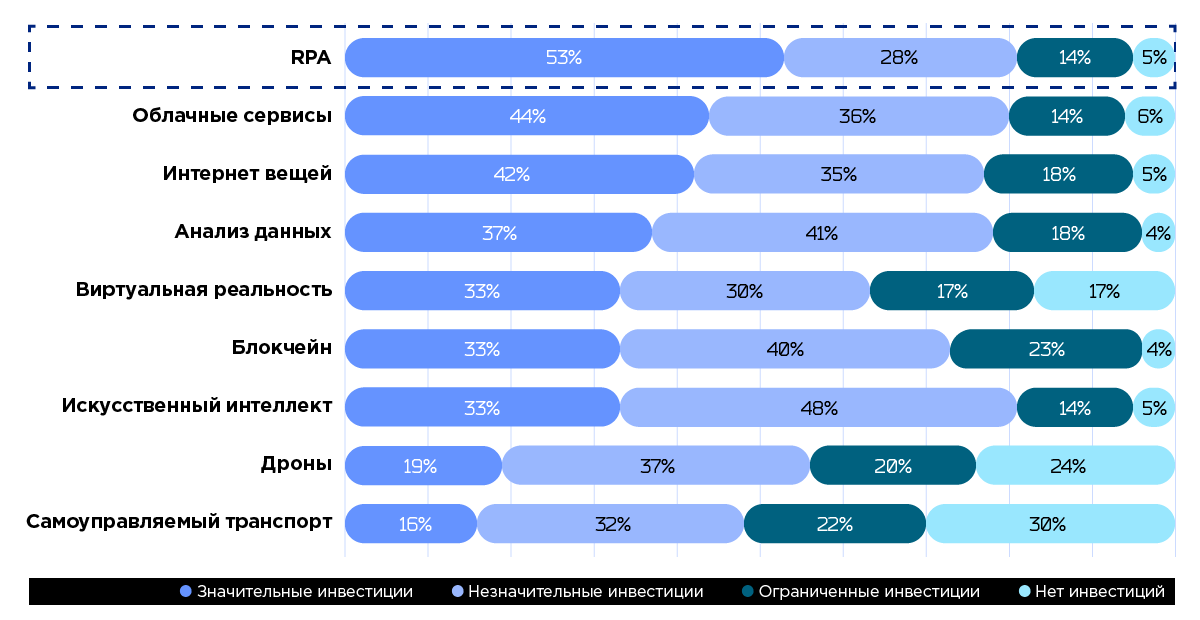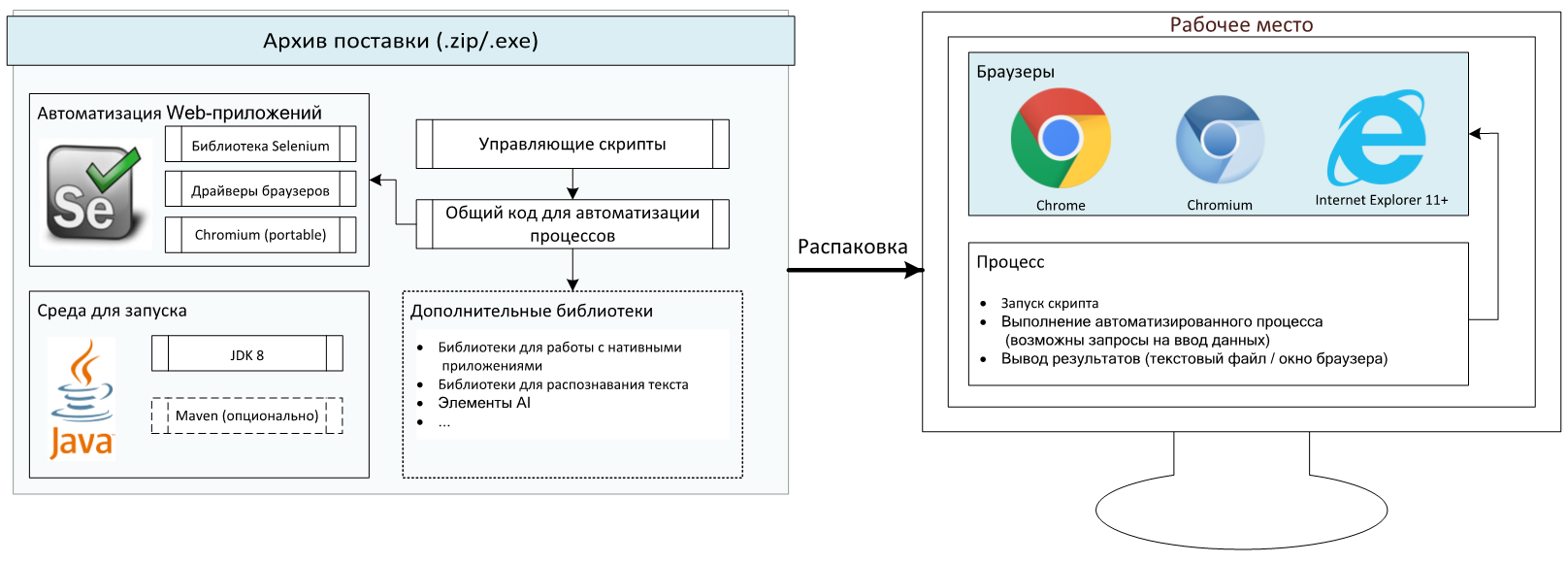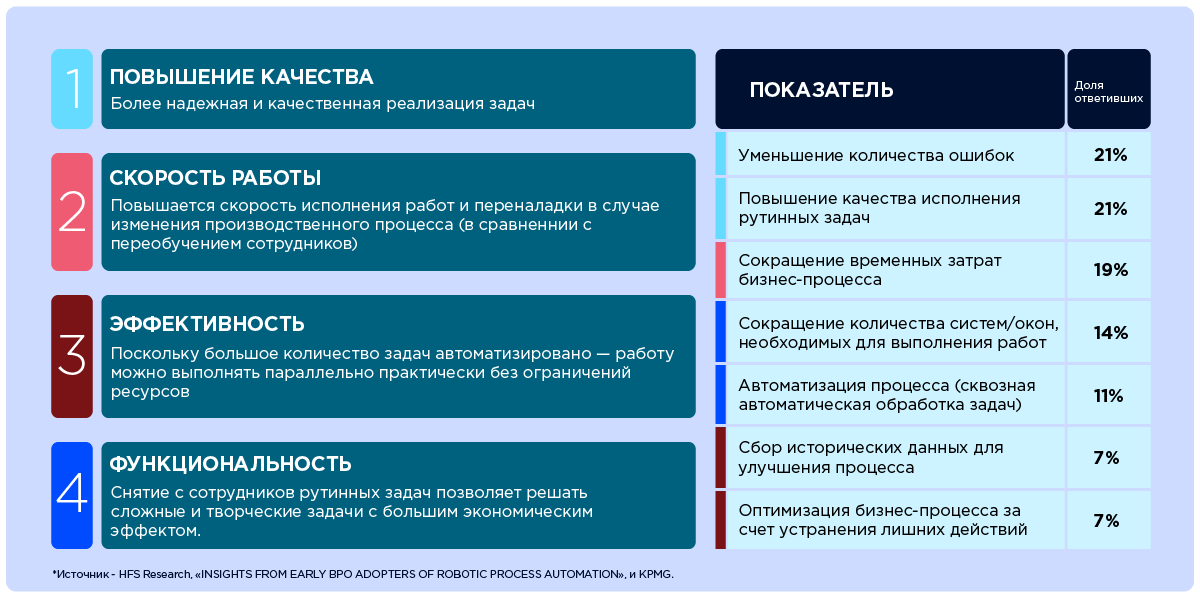Robotic Process Automation - A New Look at Old Technologies

If you come to the MFC today for any question, a lot of time is spent waiting: while the employee enters information from different documents into the required forms, ticks off, sends some queries ... And imagine a great future: you also come to the MFC, you give a passport, it is scanned, and then the magic happens - the software robot parses everything, instantly sends requests to different databases, aggregates the answers and after a few minutes gives the result / response / help / new document, simultaneously registering it in the annals.
Say, pipe dreams? But why unrealizable - suitable technologies are ready and practically tested. This is an RPA (Robotic Process Automation). The term appeared in 2012 thanks to the company Blue Prism. She became a pioneer in the field of automation of office operations management services 17 years ago. True, at that time this idea was not taken seriously and big business considered it rather utopian than real.
But that all changed with the advent of artificial intelligence systems. They radically changed the attitude towards RPA.
RPA today
Modern RPA systems can fully or partially automate the work that previously had to be done manually. Take, for example, the operational office of a large bank: 200 people more than half of their working time simply drive customers' details into the program and transfer data from one system to another, print out all sorts of receipts, invoices, certificates. And all this primitive routine can be automated.
According to GVR (Grand View Research, Inc.), by 2025, companies are expected to spend $ 3.11 billion on RPA technology.

Investment in various industries, Grand View Research
What can a robot do, for example, in retail, financial and insurance services?
- Open and close web client and email applications and systems (including attachments)
- Move within applications (ERP, CRM, etc.)
- Create and move files and folders
- Follow links and emulate button clicks
- Automatically transition between applications
- Fill out and copy forms
- Download data from external sources to the program interface and directly to the database
- Compare and verify data, perform mathematical calculations
- Work on complex logic with conditions and loops
- Recognize Text (PDF / DOC / XLS)
- Perform multi-level cross-validation of data entered by people
- Chat with clients in instant messengers using chat bots
- Use predictive analytics to manage decisions based on statistics and data mining.
Sounds nice, but what about life examples?
Automation of the process of filling out applications for a loan to legal entities
Before the introduction of the RPA system, in the process of applying for a loan for legal entities in one of the largest Russian banks, it was necessary to collect and structure data from as many as 9 different systems. Employees simply manually copied and pasted the information into Excel files. And 53 people were engaged in this highly intellectual work. And then another 6 people manually checked the entered information for errors. According to bank statistics, 20% of employees from the first group made 1-2 errors per day. At the same time, at least one of the examiners also missed one or two errors unnoticed every day.
When the RPA was introduced in this department, 30 out of 53 people were transferred to other tasks, and the number of errors when filling out applications decreased by 10-15 times.
Automation of entering information into the help system
For one of our clients, we calculated a pilot project for automating the entry of data from scans of documents into the information-reference system.
The company was engaged in 5 employees. About 5M rubles a year were spent on paying for their labor, equipping jobs and depreciating equipment. During the year, taking into account holidays, holidays and sick leaves, about 4,000 man-hours took to enter information into the system.
The main costs of the robot are the purchase of a license (usually purchased for a year) and services for the development and technical support of the system. We estimated the implementation of the robot at 600,000 rubles and requested 3 months from the customer for everything about everything. The UiPath license package costing approximately 300,000 rubles a year perfectly suited this task. And for the customer’s further support of the robot, it’s enough to spend only about 30,000 rubles a month. And even during the development and implementation of RPA, it was necessary to manually perform a robotic process.
As a result, the total automation costs were as follows: 600,000 + 300,000 + 270,000 = 1,170,000 rubles. Even if we add to this the mentioned expenses for manual execution of the process, the robot will pay off in just six months. In the first year, the client will save 46.5% (2 070 000 rubles), and in the second year, when you need to spend only on a license and regular support, the savings will be 85.2% (3 795 000 rubles).
What is behind the abbreviation RPA
Let’s now talk about what is hidden under the “hood” of popular robotic solutions. As a rule, they are based on software that is easily adaptable to your needs, which connects via the API and imitates all the necessary human actions. Here you can add chat bots, a system for recognizing text and human voices and other elements.
Each of the modules is an independent product, and all of them are controlled by a single platform that coordinates the work of the RPA (this is a kind of conductor responsible for the harmonious and clear performance of the work by the orchestra). The platform can launch robots on demand or on a schedule, give the operator visual charts on successfully completed or failed operations, and also generate detailed reports on the operation of the RPA system.
An RPA solution can be built both on the basis of Open Source products, and using proprietary software for robotics. And do not rush to draw conclusions that it is impossible to create anything good based on free software. Here everything is decided by the qualifications and professionalism of the developers.
And to illustrate, here is another example.
Free cheese only in a mousetrap?
A large bank asked us to automate the process of generating applications in the internal document management system with a large number of parameters.
The data came from an external Excel file, and after preliminary validation it was necessary to enter it into the system, fill in all the necessary fields and track the fact of successful application formation. All incorrect entries in the file must have been recorded in the electronic journal.
We proposed a software package written in Java that contained all the necessary libraries for working with the browser. The package was unpacked on the operator’s working machine, and the entire system was controlled via a web interface.

With this simple solution, we were able to speed up the performance of routine operations by about 8 times. And, most importantly, the influence of the human factor was completely ruled out.
The cost of supporting such a solution is approaching zero, since this is an internal document management system and no changes are expected in the near future. It would seem that we only automated one small screw in the huge mechanism of monotonous manual operations, and the benefits turned out to be very tangible.
The shoemaker should not be without boots
Another example of automation is using an Open Source solution. And the example is not someone else's, but our own.
We needed to free people from the need to fill out new counterparty cards in the ERP system so as not to drive information into 50–70 fields each time. It took 10 minutes for each card, and it was no wonder that somewhere to make a mistake.
We decided to do this: let the employee scan the paper, then the robot will run the tesseract-ocr utility to recognize the data, and then fill in the fields in the web form. By the way, you can improve the recognition quality of this utility using a neural network. The robot itself logs in to the system, opens the desired page in the browser and fills in all the fields. It will take him half a minute. And if we get the initial data not on paper, but in electronic form, then you can not waste time scanning and checking, the robot will execute it and fix the errors.
As a result, our employees were incredibly happy: they only had to check the correctness of filling out the form and make sure that the robot did not fail.
The effect of implementing RPA
And how would you estimate the effectiveness of RPA? This will help statistics. According to a HFS Research survey , many companies that have implemented RPA technology have gained tangible benefits and competitive advantages.

Source - HFS Research, “INSIGHTS FROM EARLY BPO ADOPTERS OF ROBOTIC PROCESS AUTOMATION“ and KPMG.
And according to information from ABBYY, the introduction of their products in RPA has allowed many organizations to significantly reduce overhead costs.

Source - ABBYY official data
What are the benefits of robotic routine processes?
- The speed of work will increase: more can be done without involving additional staff.
- Quick return on investment: the result is noticeable after the first pilot projects (usually from 4 weeks).
- Easy scaling after the first deployments.
- High accuracy: the human factor is much less likely to occur, since a person only checks the operation of the machine.
- Security: Managed Data Access Confidentiality.
- Improving the quality of service.
- Multitasking and configuration flexibility for any IT infrastructure.
- Strategic positioning of the company: a good way to switch to AI-technologies.
- Personnel development and staff turnover reduction: training and transfer to more complex tasks (for example, to the newly formed RPA competence center, which will support and develop the system).
Someone will say, "it was smooth on paper, but they forgot about the ravines." Fair remark. Like any technology, RPA is not omnipotent and carries certain risks.
Risks and limitations of RPA solutions
Robotization needs technical support to reconfigure RPA when changes in the system interface or business processes. And this is an additional cost.
RPAs require well-documented system and business process algorithms. It is impossible to robotic chaos, so you have to start with the initial audit of business processes and their formalization.
Fortunately (or unfortunately), robots cannot yet replace a person completely and completely. In any case, people are responsible for the operation of automation. Therefore, when implementing RPA, always have “Plan B” at hand: how to manually support the work of the business in the event of a failure or forced completion of the robotic process.
Trusting robots entirely and completely is not worth it — constantly monitor the entire process of robotization. And it is best to appoint a specially trained person who will be the first to respond to possible problems in the work of the RPA. So that he immediately analyzes the reasons and makes decisions to minimize financial and reputational losses.
Information security is our everything. Robots must work in a closed software circuit to avoid the influence of malware. For example, a fraudster can change the code of the robot so that he begins to transfer money to other details. Or for the robot to intentionally make mistakes in loan applications - sales will stand up, and the company's reputation will turn into slander. So trust robots only to trusted professionals and organizations,which can ensure the security of your business processes after the introduction of RPA.
Any technology replacing a person becomes an object of Luddism. Therefore, be prepared for the fact that at first many of your employees and colleagues will oppose the ideas of automation, or even sabotage them. On the one hand, for them automation is an opportunity to find a new position for themselves, to climb the career ladder. However, progress does not stand still, and some professions do die out over time. It can be assumed that in the foreseeable future there will no longer be database operators, financial operators, telephone operators, payroll specialists, financial controllers, account managers, visitor registration secretaries, first-line technical support specialists, etc.
Finally, if (or when) you begin to robotize processes in your organization, you will also need to create your own RPA competency center.
How to approach implementation of RPA?
In the end, we want to give some advice that we - no, did not suffer, but nevertheless brought out, based on our experience and the experience of our clients, who implemented RPA on their own.
Implementation steps
First of all, even before the initial audit, count the money - how much will you save on robotics? Choose the right technical solution, calculate the ROI, draw beautiful graphics. And only after that come to business with specific numbers. And do not forget to paint all the goodies that the RPA will bring to the company. Typically, such a plan works flawlessly and the business agrees.
Then you need to understand what processes will most effectively automate. Feel free to engage other companies for analysis and consultation: the side view will be wider and more objective. Such companies have extensive experience in implementing such systems, and most have sets of ready-made solutions - perhaps something will work with minimal modifications. For example, from ready-made solutions it will be possible to “assemble” the system you need. And it will cost much less than designing from scratch.
Having decided on the tools, do not rush immediately to automate everything in a row. Start with one or two pilot projects, then draw conclusions on the results and adjust future plans. Try not to automate the whole process, but each of its operations. So it will be easier to maintain the solution and implement it in other processes of the company.
IS and ubiquitous testing
Do not neglect information security! Any robotic process should be isolated as much as possible from external influence and overlaid with control and management tools. Assign the person responsible for the work of the RPA and begin to select like-minded people into his team.
Test any robot solution very meticulously. You can even arrange acceptance testing by teams of other vendors, not those who developed your RPA solution.
How to live with RPA?
Again, do not forget about people who can - and most likely will - perceive robots as competitors in the food chain. Tell employees of the departments in which you implement RPA about the features of the system, discuss the further professional development of employees whose work the robot will now do. Bring the idea: the main goal of robotics is to do work faster and more accurately, and not to fire people. If a person from 9 to 18 was engaged in a boring routine, then now he has a chance to do more interesting and intellectual tasks, to become a specialist in a new field.
If you think that robotization will take root in the company, then invest in the training of your own specialists in supporting and developing the system. Perhaps at first glance this is not obvious, but in the long run it will be cheaper and many times more effective than hiring professionals on the side.
And the last piece of advice - when doing robots, keep your nose up to the wind of global trends. And then you can solve more and more complex problems.
Alexander Sadykov, Deputy Head of Jet Infosystems Testing Department
